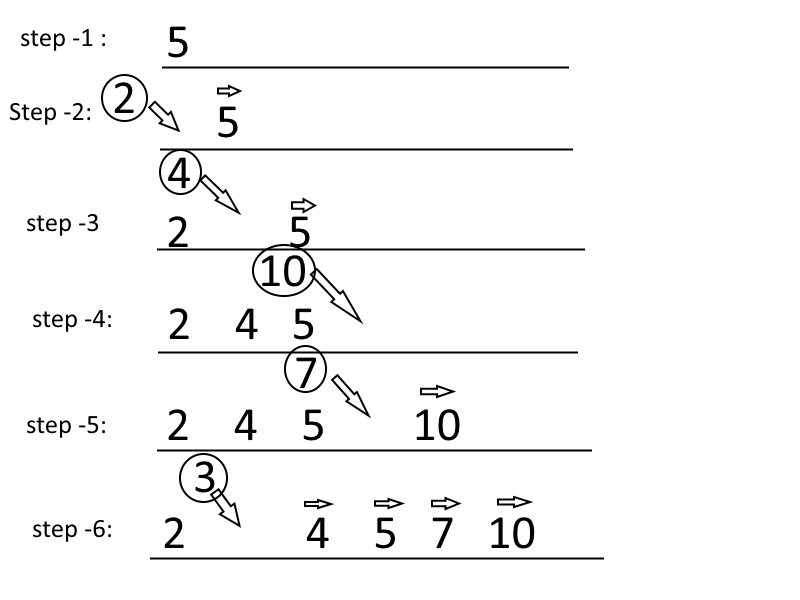Как делать сортировку в javascript при помощи sort()
Содержание:
- Запись свойств (полей) объекта
- Most methods support “thisArg”
- JavaScript учебник
- Поддержка других типов
- Сортировка многомерных массивов
- Find the Highest (or Lowest) Array Value
- Summary
- Creating a Dynamic Sorting Function
- Собственные Min / Max JavaScript методы
- Сортировка по имени
- Массивы на «стероидах»
- Sorting Ascending and Descending
- Finding Specified Values
- Symbol.iterator
- Bubble Sort
- Добавление/удаление элементов
- Insertion sort
- Найдите наибольшее (или наименьшее) значение массива
- Java Array sort Method syntax
- JS Tutorial
- Итого
Запись свойств (полей) объекта
Объекты в массивах могут содержать самые разные поля и значения, которые зависят от того, что вам необходимо реализовать в скрипте. Причем названия полей (свойств) объекта могут быть в виде одного или нескольких слов. В последнем случае в обязательном порядке нужно помещать название поля в кавычки и обращаться к такому полу нужно, как к элементу ассоциативного массива. Например, мы имеем такой объект:
Вывод полей объекта
JavaScript
let myObj = {
‘model phone’: ‘Xiaomi Redmi Note 8 Pro 6/128GB’,
‘processor’: ‘MediaTek Helio G90T’,
‘camera’: ’64 Мп + 8 Мп + 2 Мп + 2 Мп’
}
console.log(myObj)
console.log(myObj);
|
1 |
let myObj={ ‘model phone»Xiaomi Redmi Note 8 Pro 6/128GB’, ‘processor»MediaTek Helio G90T’, ‘camera»64 Мп + 8 Мп + 2 Мп + 2 Мп’ } console.log(myObj’model phone’) console.log(myObj’processor’); |
Поле выдаст ошибку, если не взять его в кавычки. Если же оно будет в кавычках, то все будет в порядке.

На данный момент вы даже можете сформировать объект со свойствами (полями), которые имеют кириллические символы. Например, вывод информации о модели телефона можно представить в таком виде:
Объект с полями с кириллическими символами
JavaScript
let phone1 = {
Модель: ‘Мобильный телефон Samsung Galaxy M21 4/64GB’,
Экран: ‘6.4″, Super AMOLED, 2340х1080’,
Процессор: ‘Samsung Exynos 9611 (4 x 2.3 ГГц + 4 x 1.7 ГГц)’,
‘Количество СИМ-карт’: ‘2 (Nano-SIM)’,
ОС: ‘Android 10 (Q)’,
Камеры: ‘тройная основная камера: 48 Мп + 8 Мп + 5 Мп, фронтальная 20 Мп’,
‘Оперативная память’: ‘RAM 4 ГБ’,
‘Встроенная память’: ’64 ГБ’,
‘Дополнительная память’: ‘microSD (до 512 ГБ)’,
‘Беспроводные технологии’: ‘3G / LTE / Bluetooth 5.0/ NFC / Wi-Fi’,
‘Емкость батареи’: ‘6000 мА*ч’,
Цена: ‘6299 грн.’,
‘Цена со скидкой’: ‘5555 грн.’
}
for(key in phone1){
document.write(`<p><strong>${key}</strong>: ${phone1}</p>`);
}
|
1 |
let phone1={ Модель’Мобильный телефон Samsung Galaxy M21 4/64GB’, Экран’6.4″, Super AMOLED, 2340х1080′, Процессор’Samsung Exynos 9611 (4 x 2.3 ГГц + 4 x 1.7 ГГц)’, ‘Количество СИМ-карт»2 (Nano-SIM)’, ОС’Android 10 (Q)’, Камеры’тройная основная камера: 48 Мп + 8 Мп + 5 Мп, фронтальная 20 Мп’, ‘Оперативная память»RAM 4 ГБ’, ‘Встроенная память»64 ГБ’, ‘Дополнительная память»microSD (до 512 ГБ)’, ‘Беспроводные технологии»3G / LTE / Bluetooth 5.0/ NFC / Wi-Fi’, ‘Емкость батареи»6000 мА*ч’, Цена’6299 грн.’, ‘Цена со скидкой»5555 грн.’ } for(key inphone1){ document.write(`<p><strong>${key}<strong>${phone1key}<p>`); } |
Такая запись выглядит довольно непривычно, но обрабатывается интерпретатором корректно. В кавычки помещены те свойства объекта, которые содержат в своем названии 2 слова.
Результат выполнения скрипта:
Most methods support “thisArg”
Almost all array methods that call functions – like , , , with a notable exception of , accept an optional additional parameter .
That parameter is not explained in the sections above, because it’s rarely used. But for completeness we have to cover it.
Here’s the full syntax of these methods:
The value of parameter becomes for .
For example, here we use a method of object as a filter, and passes the context:
If in the example above we used , then would be called as a standalone function, with , thus leading to an instant error.
A call to can be replaced with , that does the same. The latter is used more often, as it’s a bit easier to understand for most people.
JavaScript учебник
JS HOMEJS IntroductionJS Where ToJS OutputJS StatementsJS SyntaxJS CommentsJS VariablesJS OperatorsJS ArithmeticJS AssignmentJS Data TypesJS FunctionsJS ObjectsJS ScopeJS EventsJS StringsJS String MethodsJS NumbersJS Number MethodsJS ArraysJS Array MethodsJS Array SortJS Array IterationJS DatesJS Date FormatsJS Date Get MethodsJS Date Set MethodsJS MathJS RandomJS BooleansJS ComparisonsJS ConditionsJS SwitchJS Loop ForJS Loop WhileJS BreakJS Type ConversionJS BitwiseJS RegExpJS ErrorsJS DebuggingJS HoistingJS Strict ModeJS this KeywordJS Style GuideJS Best PracticesJS MistakesJS PerformanceJS Reserved WordsJS VersionsJS Version ES5JS Version ES6JS JSON
Поддержка других типов
Чтобы работать с другими типами, нужно добавить настраиваемый атрибут к каждому заголовку, чтобы указать тип его ячеекю В нашем случае мы добавили к столбцу с цифровыми кодами валют тип :
<thead>
<tr>
<th>Currency</th>
<th>Буквенный</th>
<th data-type="number">Числовой</th>
<th>Валюта</th>
</tr>
</thead>
Если атрибут отсутствует, типы содержимого ячеек являются строковыми. Создадим функцию для преобразования содержимого ячеек из строкового в другой тип (в нашем случае number), используя инструкцию switch:
// Преобразовать содержимое данной ячейки в заданном столбце
const transform = function(index, content) {
// Получаем тип данных столбца
const type = headers.getAttribute('data-type');
switch (type) {
case 'number':
return parseFloat(content);
case 'string':
default:
return content;
}
};
Теперь вместо сравнения необработанного контента мы сравниваем значения, которые конвертируются в зависимости от типа контента:
newRows.sort(function(rowA, rowB) {
const cellA = rowA.querySelectorAll('td').innerHTML;
const cellB = rowB.querySelectorAll('td').innerHTML;
// Преобразуем содержимое ячеек
const a = transform(index, cellA);
const b = transform(index, cellB);
// И сравним их
switch (true) {
case a > b: return 1;
case a < b: return -1;
case a === b: return 0;
}
});
Сортировка многомерных массивов
Создадим функцию, которая нам поможет в сортировке массивов
// создадим функцию которая нам поможет в сортировке массивов
function array_orderby()
{
$args = func_get_args();
$data = array_shift($args);
foreach ($args as $n => $field) {
if (is_string($field)) {
$tmp = array();
foreach ($data as $key => $row)
$tmp = $row;
$args = $tmp;
}
}
$args[] = &$data;
call_user_func_array('array_multisort', $args);
return array_pop($args);
}
Пример работы этой функции :
$data = , , , , , , ]; // Сортируем массив $data сначала по volume, затем по edition $sorted = array_orderby($data, 'volume', SORT_DESC, 'edition', SORT_ASC); // SORT_ASC - по возрастанию // SORT_DESC - по убыванию print_r($sorted); // выводим результат
Find the Highest (or Lowest) Array Value
There are no built-in functions for finding the max or min
value in an array.
However, after you have sorted an array, you can use the
index to obtain the highest and lowest values.
Sorting ascending:
Example
const points = ;
points.sort(function(a, b){return a — b});
// now points contains the lowest value
// and points contains the highest value
Sorting descending:
Example
const points = ;
points.sort(function(a, b){return b — a});
// now points contains the highest value
// and points contains the lowest value
Sorting a whole array is a very inefficient method if you only want to find the highest (or lowest) value.
Summary
A cheat sheet of array methods:
-
To add/remove elements:
- – adds items to the end,
- – extracts an item from the end,
- – extracts an item from the beginning,
- – adds items to the beginning.
- – at index deletes elements and inserts .
- – creates a new array, copies elements from index till (not inclusive) into it.
- – returns a new array: copies all members of the current one and adds to it. If any of is an array, then its elements are taken.
-
To search among elements:
- – look for starting from position , return the index or if not found.
- – returns if the array has , otherwise .
- – filter elements through the function, return first/all values that make it return .
- is like , but returns the index instead of a value.
-
To iterate over elements:
forEach(func) – calls func for every element, does not return anything.
-
To transform the array:
- – creates a new array from results of calling for every element.
- – sorts the array in-place, then returns it.
- – reverses the array in-place, then returns it.
- – convert a string to array and back.
- – calculate a single value over the array by calling for each element and passing an intermediate result between the calls.
-
Additionally:
Array.isArray(arr) checks arr for being an array.
Please note that methods , and modify the array itself.
These methods are the most used ones, they cover 99% of use cases. But there are few others:
-
arr.some(fn)/arr.every(fn) check the array.
The function is called on each element of the array similar to . If any/all results are , returns , otherwise .
These methods behave sort of like and operators: if returns a truthy value, immediately returns and stops iterating over the rest of items; if returns a falsy value, immediately returns and stops iterating over the rest of items as well.
We can use to compare arrays:
-
arr.fill(value, start, end) – fills the array with repeating from index to .
-
arr.copyWithin(target, start, end) – copies its elements from position till position into itself, at position (overwrites existing).
-
arr.flat(depth)/arr.flatMap(fn) create a new flat array from a multidimensional array.
For the full list, see the manual.
From the first sight it may seem that there are so many methods, quite difficult to remember. But actually that’s much easier.
Look through the cheat sheet just to be aware of them. Then solve the tasks of this chapter to practice, so that you have experience with array methods.
Afterwards whenever you need to do something with an array, and you don’t know how – come here, look at the cheat sheet and find the right method. Examples will help you to write it correctly. Soon you’ll automatically remember the methods, without specific efforts from your side.
Creating a Dynamic Sorting Function
Let’s finish up by making this more dynamic. Let’s create a sorting function, which you can use to sort an array of objects, whose values are either strings or numbers. This function has two parameters — the key we want to sort by and the order of the results (i.e. ascending or descending):
And this is how you’d use it:
Try it out
See the Pen
OJJopmx by SitePoint (@SitePoint)
on CodePen.
In the code above, the hasOwnProperty method is used to check if the specified property is defined on each object and has not been inherited via the prototype chain. If it’s not defined on both objects, the function returns , which causes the sort order to remain as is (i.e. the objects remain unchanged with respect to each other).
The typeof operator is also used to check the data type of the property’s value. This allows the function to determine the proper way to sort the array. For example, if the value of the specified property is a , a method is used to convert all its characters to uppercase, so character casing is ignored when sorting.
You can adjust the above function to accommodate other data types, and any other needs your script may have.
Собственные Min / Max JavaScript методы
Самым быстрым решением является использование метода «home made» («сделаного самим»).
Эта функция просматривает массив, сравнивая каждое значение с наибольшим найденным значением:
Пример (Найти Max-значение)
function myArrayMax(arr) {
let len = arr.length;
let max = -Infinity;
while (len—) {
if (arr > max) {
max = arr; } } return max;}
Эта функция просматривает массив, сравнивая каждое значение с наименьшим найденным значением:
Пример (Найти Min-значение)
function myArrayMin(arr) { let len = arr.length; let min = Infinity; while (len—) {
if (arr < min) {
min = arr; } } return min;}
Сортировка по имени
В наши дни сортировка по возрасту сотрудника может выглядеть довольно бесчувственной и некорректной, так что давайте отсортируем по именам сотрудников в возрастающем порядке. Вспомните, что по-дефолту, сортировка массива, который содержит примитивы, такие как строки, происходит в алфавитном порядке. Что говорит о том, что вам просто надо вызвать метод, без любой функции сравнения, в общем просто . Это не работает, так как данные по которым мы хотим отсортировать не являются массивом. Так что же делать? Фокус тут в том, чтобы вручную написать функцию сравнения, которая отсортирует массив по-алфавиту, что в свою очередь даст нам указать где находятся данные строк. Давайте посмотрим:
employees.sort(function(a, b){var nameA=a.name.toLowerCase(), nameB=b.name.toLowerCase()if (nameA < nameB) //сортируем строки по возрастанию return -1if (nameA > nameB) return 1return 0 // Никакой сортировки})
Это отсортирует массив employees по именам в возрастающем порядке, так что теперь это Christine, это Edward и так далее. Тут мы сравниваем две строки a.name с b.name и возвращаем -1, 1 или 0, в соответствии с сортировкой, точно определенной формулой, которую использует сам , без передачи какой-либо другой функции. Как вы уже наверное выяснили, в JavaScript вы можете без сомнений сравнивать две строки.
Массивы на «стероидах»
Часто работаете с массивами? Тогда вам понравится это расширение для работы с коллекциями.
Рассмотрим несколько примеров.
Простая сортировка чисел:
$collection = collect(); $sorted = $collection->sort(); $sorted->values()->all(); //
Сортировка по одной «колонке» ассоциативного массива:
$collection = collect(,
,
,
]);
$sorted = $collection->sortBy('price');
$sorted->values()->all();
/*
,
,
,
]
*/
Сортировка по нескольким аттрибутам одновременно:
$collection = collect(,
,
,
,
]);
$sorted = $collection->sortBy(,
,
]);
$sorted->values()->all();
/*
,
,
,
,
]
*/
Вы также можете использовать свои функции сортировки при работе с коллекциями:
$collection = collect(,
,
,
,
]);
$sorted = $collection->sortBy( <=> $b,
fn ($a, $b) => $b <=> $a,
]);
$sorted->values()->all();
/*
,
,
,
,
]
*/
Коллекции позволяют работать с массивами как в Laravel и функции этого замечательного инструмента далеко не ограничиваются сортировкой.
Изучите документацию и вы влюбитесь в коллекции.
Помогла ли Вам эта статья?
Да
Нет
Sorting Ascending and Descending
The first time you click the button, the sorting direction is ascending (A to Z).
Click again, and the sorting direction will be descending (Z to A):
Sort
- Oslo
- Stockholm
- Helsinki
- Berlin
- Rome
- Madrid
Example
<ul id=»id01″> <li>Oslo</li> <li>Stockholm</li>
<li>Helsinki</li> <li>Berlin</li> <li>Rome</li>
<li>Madrid</li></ul><script>function sortListDir() {
var list, i, switching, b, shouldSwitch, dir, switchcount = 0; list
= document.getElementById(«id01»); switching = true; // Set
the sorting direction to ascending: dir = «asc»; // Make a
loop that will continue until no switching has been done: while
(switching) { // Start by saying: no switching is done:
switching = false; b = list.getElementsByTagName(«LI»);
// Loop through all list-items: for (i = 0; i < (b.length
— 1); i++) { // Start by saying there should
be no switching: shouldSwitch = false;
/* Check if the next item should switch place with the current item,
based on the sorting direction (asc or desc): */
if (dir == «asc») { if (b.innerHTML.toLowerCase()
> b.innerHTML.toLowerCase()) {
/* If next item is alphabetically lower than current item,
mark as a switch and break the loop: */
shouldSwitch = true;
break; }
} else if (dir == «desc») { if
(b.innerHTML.toLowerCase() < b.innerHTML.toLowerCase()) {
/* If next item is alphabetically higher than current item,
mark as a switch and break the loop: */
shouldSwitch= true;
break; }
} } if (shouldSwitch) {
/* If a switch has been marked, make the switch
and mark that a switch has been done: */
b.parentNode.insertBefore(b, b);
switching = true; // Each time a switch is
done, increase switchcount by 1: switchcount
++; } else { /* If no
switching has been done AND the direction is «asc»,
set the direction to «desc» and run the while loop again. */
if (switchcount == 0 && dir == «asc») {
dir = «desc»; switching = true;
} } }}</script>
Finding Specified Values
Currently, there are no integrated functions for locating the minimum or maximum values of the array. However, you can solve this issue by obtaining the index of the lowest and the highest value in a sorted array. Then, you will be able to create ascending or descending lists. You can see both kinds created in the code examples below:
Example Copy
Example Copy
Math.max()
When trying to find the highest number in the whole array, you can use the . This way, you don’t have to use the numeric JavaScript sort array function to sort out the whole list. The function will return only the highest number:
Example Copy
Math.min()
Similarly to method, you can locate the lowest number in the whole array using method. This will only return the lowest number in the array:
Example Copy
Custom Min/Max Methods
The least time-consuming way is to use a JS array sorting method which is, let’s say, homemade. Each value is compared with the highest value located in this while loop.Check out the possibilities that arise:
Example Copy
Each value is compared with the lowest value located in this loop:
Example Copy
Symbol.iterator
Мы легко поймём принцип устройства перебираемых объектов, создав один из них.
Например, у нас есть объект. Это не массив, но он выглядит подходящим для .
Например, объект , который представляет собой диапазон чисел:
Чтобы сделать итерируемым (и позволить работать с ним), нам нужно добавить в объект метод с именем (специальный встроенный , созданный как раз для этого).
- Когда цикл запускается, он вызывает этот метод один раз (или выдаёт ошибку, если метод не найден). Этот метод должен вернуть итератор – объект с методом .
- Дальше работает только с этим возвращённым объектом.
- Когда хочет получить следующее значение, он вызывает метод этого объекта.
- Результат вызова должен иметь вид , где означает, что итерация закончена, в противном случае содержит очередное значение.
Вот полная реализация с пояснениями:
Обратите внимание на ключевую особенность итераторов: разделение ответственности
- У самого нет метода .
- Вместо этого другой объект, так называемый «итератор», создаётся вызовом , и именно его генерирует значения.
Таким образом, итератор отделён от самого итерируемого объекта.
Технически мы можем объединить их и использовать сам как итератор, чтобы упростить код.
Например, вот так:
Теперь возвращает сам объект : у него есть необходимый метод , и он запоминает текущее состояние итерации в . Короче? Да. И иногда такой способ тоже хорош.
Недостаток такого подхода в том, что теперь мы не можем использовать этот объект в двух параллельных циклах : у них будет общее текущее состояние итерации, потому что теперь существует лишь один итератор – сам объект. Но необходимость в двух циклах , выполняемых одновременно, возникает редко, даже при наличии асинхронных операций.
Бесконечные итераторы
Можно сделать бесконечный итератор. Например, будет бесконечным при . Или мы можем создать итерируемый объект, который генерирует бесконечную последовательность псевдослучайных чисел. Это бывает полезно.
Метод не имеет ограничений, он может возвращать всё новые и новые значения, это нормально.
Конечно же, цикл с таким итерируемым объектом будет бесконечным. Но мы всегда можем прервать его, используя .
Bubble Sort
How it works:
step-1: you compare the first item with the second. If the first item is bigger than the second item. you swap them so that the bigger one stays in the second position.
step-2:And then compare second with third item. if second item is bigger than the third, we swap them. otherwise, they stayed in their position. Hence, the biggest among first three is in the third position.
step-3:we keep doing it. until we hit the last element of the array. In that way we bubble up the biggest item of the array to the right most position of the array.
step-4: Look at the inner loop in the code below.
step-5: We repeat this process, starting from the last item of the array. look at the outer loop in the code below. We do this way, so that after finishing the first inner loop, the biggest one will be in the last item of the array.
step-6: and then we move backward inside the outer loop.
same thing is going on….
Добавление/удаление элементов
Мы уже знаем методы, которые добавляют и удаляют элементы из начала или конца:
- – добавляет элементы в конец,
- – извлекает элемент из конца,
- – извлекает элемент из начала,
- – добавляет элементы в начало.
Есть и другие.
Как удалить элемент из массива?
Так как массивы – это объекты, то можно попробовать :
Вроде бы, элемент и был удалён, но при проверке оказывается, что массив всё ещё имеет 3 элемента .
Это нормально, потому что всё, что делает – это удаляет значение с данным ключом . Это нормально для объектов, но для массивов мы обычно хотим, чтобы оставшиеся элементы сдвинулись и заняли освободившееся место. Мы ждём, что массив станет короче.
Поэтому для этого нужно использовать специальные методы.
Метод arr.splice(str) – это универсальный «швейцарский нож» для работы с массивами. Умеет всё: добавлять, удалять и заменять элементы.
Его синтаксис:
Он начинает с позиции , удаляет элементов и вставляет на их место. Возвращает массив из удалённых элементов.
Этот метод проще всего понять, рассмотрев примеры.
Начнём с удаления:
Легко, правда? Начиная с позиции , он убрал элемент.
В следующем примере мы удалим 3 элемента и заменим их двумя другими.
Здесь видно, что возвращает массив из удалённых элементов:
Метод также может вставлять элементы без удаления, для этого достаточно установить в :
Отрицательные индексы разрешены
В этом и в других методах массива допускается использование отрицательного индекса. Он позволяет начать отсчёт элементов с конца, как тут:
Метод arr.slice намного проще, чем похожий на него .
Его синтаксис:
Он возвращает новый массив, в который копирует элементы, начиная с индекса и до (не включая ). Оба индекса и могут быть отрицательными. В таком случае отсчёт будет осуществляться с конца массива.
Это похоже на строковый метод , но вместо подстрок возвращает подмассивы.
Например:
Можно вызвать и вообще без аргументов: создаёт копию массива . Это часто используют, чтобы создать копию массива для дальнейших преобразований, которые не должны менять исходный массив.
Метод arr.concat создаёт новый массив, в который копирует данные из других массивов и дополнительные значения.
Его синтаксис:
Он принимает любое количество аргументов, которые могут быть как массивами, так и простыми значениями.
В результате мы получаем новый массив, включающий в себя элементы из , а также , и так далее…
Если аргумент – массив, то все его элементы копируются. Иначе скопируется сам аргумент.
Например:
Обычно он просто копирует элементы из массивов. Другие объекты, даже если они выглядят как массивы, добавляются как есть:
…Но если объект имеет специальное свойство , то он обрабатывается как массив: вместо него добавляются его числовые свойства.
Для корректной обработки в объекте должны быть числовые свойства и :
Insertion sort
How it works: Imagine you are playing cards. Somebody is giving you cards one by one. When you are receiving card, you are planning to put them in a way so that the smaller one is on the left. This means you want to insert them in a sorted way
step-1: If the first card you are getting is 5. Just hold the card in your hand. you dont have to do anything.
step-2: If the second card is 2, you want to put it before 5 so that the two cards you have are sorted. When you are putting the card with number 2 at the left, you are changing the position of the card 5 from first position to second position. And then first position becomes available and you put 2 there.
step-3: If the third card is 4. you will start from second position. In the second position, you have card 5 which is bigger than 4. Hence you will move 5 to the third position. The next card to the left is 2 which is smaller than 4. Hence, you wont move 2. And you will insert card 4 in the second position.
step-4: Then you got 10. It is bigger than the previous card which is 5. Hence, you just add it at the last position.
step-5: The next card is 7. You just move the position of the card 10 to the right and insert card 7.
step-6: If the last card is 3. You will have to move 10 to the right as it is bigger than 3. and then you check with the next card to the left it is 7 which is bigger than 3. you move it to the right. similarly, you move 5, 4 to the right. And put the number 3 before 2 as 2 is smaller than 3.
congrats. you are done.

Code Insertion sort: Code is similar to the card and image above. It starts with the second element. Pick the second element to be inserted and then compare to the previous element. If the first one is bigger, move the first one to second position and second one at first.
Now first and second item is sorted.
Then, pick the third element and check whether the second element is bigger than the third. keep going similar way until you hit the first element or a element smaller than the element you are comparing with. When you get an item smaller than the picked item, you insert it.
super easy.
Найдите наибольшее (или наименьшее) значение массива
Нет встроенных функций для поиска максимального или минимального значения в массиве.
Однако после того, как вы отсортировали массив, вы можете использовать индекс для получения наибольшего и наименьшего значений.
Сортировка по возрастанию:
Пример
const points = ;
points.sort(function(a, b){return a — b});
// теперь points содержит наименьшее значение
// и points содержит наибольшее значение
Сортировка по убыванию:
Пример
const points = ;
points.sort(function(a, b){return b — a});
// теперь points содержит наибольшее значение
// и points содержит наименьшее значение
Сортировка всего массива — очень неэффективный метод, если вы хотите найти только самое высокое (или самое низкое) значение.
Java Array sort Method syntax
The Java Programming Language provides eighteen different Java Array sort methods to perform sorting on the Java Array. The following method will accept the Byte Array as the parameter and sort the Byte array in Ascending Order.
The following Java Arrays.sort method will accept the Byte Array as the first argument. The starting index position (fromIndex) where the sorting will begin as the second parameter (integer value), and last index position (toIndex) where the sorting will end as the third argument. The Arrays sort method will sort the array elements starting from the fromIndex up to toIndex but not included.
Below Java Arrays.sort method will accept the short Array as the parameter and sort the Short array in Ascending.
It accepts the Short Array as the first argument, starting index position (fromIndex) as the second parameter, and last index position (toIndex) as the third argument.
It will accept the Character Array as the parameter and sort the char array in Ascending.
This Java Arrays.sort method accepts the Character Array as the first argument, starting index position (fromIndex), and last index position (toIndex) as the third argument.
It accepts the Integer Array as the parameter and sorts the Int array in Ascending order.
This Java Arrays.sort method will accept the Integer Array as the first argument, the starting index position (fromIndex), where the sorting will begin as the second parameter. And last index position (toIndex), where the sorting will end as the third argument.
The following method will accept the Long Array as the parameter and sort the Long array in Ascending order.
It accepts the Long Array as the first argument, fromIndex as the second parameter, and toIndex as the third argument.
The Java Arrays sort method will accept the Double Array as the parameter and sort the Double array in Ascending order.
The following method will accept the Double Array, starting index position (fromIndex) as the second parameter, and last index position (toIndex) as the third argument.
This Java sort method will accept the Floating-point Array as the parameter and sort the Float array in Ascending order.
It accepts the Floating-point Array, starting index position (fromIndex), and last index position (toIndex).
This array sort method accepts the Object Array as the parameter. It sorts the Object array in the order induced by the specified Comparator.
The Java sort method accepts the Object Array, starting index position (fromIndex), last index position (toIndex), and Comparator (specify the Order) as the fourth argument.
- fromIndex: Please specify the starting index position. It is the index position where the Sorting will begin.
- toIndex: Please specify the ending index position. Java Arrays.sort method will sort up to this index position. However, it will not include the element at this position (toIndex).
JS Tutorial
JS HOMEJS IntroductionJS Where ToJS OutputJS StatementsJS SyntaxJS CommentsJS VariablesJS LetJS ConstJS OperatorsJS ArithmeticJS AssignmentJS Data TypesJS FunctionsJS ObjectsJS EventsJS StringsJS String MethodsJS String SearchJS String TemplatesJS NumbersJS Number MethodsJS ArraysJS Array MethodsJS Array SortJS Array IterationJS Array ConstJS DatesJS Date FormatsJS Date Get MethodsJS Date Set MethodsJS MathJS RandomJS BooleansJS ComparisonsJS ConditionsJS SwitchJS Loop ForJS Loop For InJS Loop For OfJS Loop WhileJS BreakJS IterablesJS SetsJS MapsJS TypeofJS Type ConversionJS BitwiseJS RegExpJS ErrorsJS ScopeJS HoistingJS Strict ModeJS this KeywordJS Arrow FunctionJS ClassesJS JSONJS DebuggingJS Style GuideJS Best PracticesJS MistakesJS PerformanceJS Reserved Words
Итого
Объекты, которые можно использовать в цикле , называются итерируемыми.
- Технически итерируемые объекты должны иметь метод .
- Результат вызова называется итератором. Он управляет процессом итерации.
- Итератор должен иметь метод , который возвращает объект , где сигнализирует об окончании процесса итерации, в противном случае – следующее значение.
- Метод автоматически вызывается циклом , но можно вызвать его и напрямую.
- Встроенные итерируемые объекты, такие как строки или массивы, также реализуют метод .
- Строковый итератор знает про суррогатные пары.
Объекты, имеющие индексированные свойства и , называются псевдомассивами. Они также могут иметь другие свойства и методы, но у них нет встроенных методов массивов.
Если мы заглянем в спецификацию, мы увидим, что большинство встроенных методов рассчитывают на то, что они будут работать с итерируемыми объектами или псевдомассивами вместо «настоящих» массивов, потому что эти объекты более абстрактны.
создаёт настоящий из итерируемого объекта или псевдомассива , и затем мы можем применять к нему методы массивов. Необязательные аргументы и позволяют применять функцию с задаваемым контекстом к каждому элементу.




